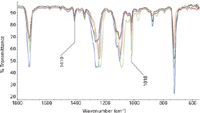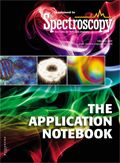Article
Application Notebook
Application Notebook
Investigating Polymer Orientation with FTIR-ATR
Polymer orientation of a blow-molded plastic was investigated using FTIR-ATR with polarization. By using a variable angle ATR accessory, changes in spectral features were observed at two different probing depths.
Polymer orientation of a blow-molded plastic was investigated using FTIR-ATR with polarization. By using a variable angle ATR accessory, changes in spectral features were observed at two different probing depths.
A polarizer may offer a valuable FTIR sampling enhancement to elucidate chemical information not otherwise found when using nonpolarized light. Typical IR applications determine molecular orientation and investigate chemical bonding of materials such as fibers, polymers, and biopolymers.
For some materials the degree of polymer orientation will vary as a function of sample depth due to stresses introduced in the manufacturing processes. Understanding orientation is important because it has implications on the mechanical properties such as Young's modulus and tensile strength.
Experimental Conditions
FTIR spectra of polyethylene terephthalate (PET) from a blow-molded bottle were collected using the variable angle VeeMAX III with ATR (PIKE Technologies). The ATR crystal type was ZnSe. Two angles of incidence were investigated: 52° and 64°. Sample orientation was held constant while polarization was changed between perpendicular (TE) and parallel (TM) polarization. The data collection time for the background and the sample was 1 min.
Results
By changing the incidence angle of the infrared beam (or the ATR crystal type) it was possible to investigate spectral characteristics as a function of sample depth. The depths of penetration probed at 1018 cm-1 were 1.4 and 2.9 μ, which corresponds to the angles of incidence of 64° and 52°, respectively.
Spectral differences for PET were observed as a function of polarization direction and depth of penetration (Figure 1). As a quantifiable indicator the absorbance ratio of the 1018 cm-1 band against the 1410 cm-1 band was calculated for each TE (perpendicular) and TM (parallel) polarization. These absorbance bands are caused by phenylene ring vibration, where the absorbance band at 1410 cm-1 is nondichroic, meaning it is not affected by polarization or sample orientation (1). Normalizing against a nondichroic absorbance band minimizes the influence of sample contact against the ATR crystal (2).

Figure 1: PET spectra; depth 1.4 μ, TM (blue); depth 1.4 μ, TE (red); depth 2.9 μ, TM (black); depth 2.9 μ, TE (green).
When the angle of incidence is set to 64° (1.4 μ), the absorbance ratio for TE and TM polarization is 2.55 and 1.71, respectively. By decreasing the angle of incidence to 52° (2.9 μ), the absorbance ratio of TM and TE is 3.95 and 1.50. The change in the absorbance ratio as a function of penetration depth into the sample indicates structural differences and may be explored using the versatile VeeMAX III with ATR and polarizer. Previous work also noted orientation gradients within a bottle from which samples were obtained by microtoming layers instead of depth profiling (3).
Conclusions
Polymer orientation may be explored using ATR in conjunction with a polarizer. Using a variable angle ATR accessory allows for probing at various depths.
References
(1) Y. Wang and S. Lehmann, Appl. Spectrosc. 53, 914–918 (1999).
(2) N.J. Everall and A. Bibby, Appl. Spectrosc. 51, 1083–1091 (1997).
(3) N. Everall, D. MacKerron, and D. Winter, Polymer 43, 4217–4223 (2002).

PIKE Technologies, Inc.
6125 Cottonwood Drive, Madison, WI 53719
tel. (608) 274-2721
Website: www.piketech.com

Newsletter
Get essential updates on the latest spectroscopy technologies, regulatory standards, and best practices—subscribe today to Spectroscopy.